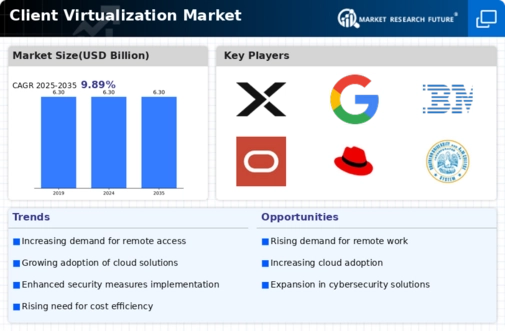Market Trends
Key Emerging Trends in the Client Virtualization Market
The market of Client Virtualization, specifically is confirming singular trends that are evoking the passage of the landscape of end-user computing and IT infrastructure. A particularly interesting shift is when VDI or Virtual Desktop Infrastructure (VDI) becomes the standard of the organizations. VDI delivers centralized desktop management and enables providers of end-user desktops to access these from different devices. This recognition is largely explained by the factors, comprising better security level, streamlined management of the data, and better support of the emerging remote work and BYOD concepts.
The increasing popularity of the Remote Desktop Services (RDS) in the market is improving not only the Client Virtualization but also the Enterprise Virtualization. RDS facilitates the provisioning of virtualized desktops and applications to end-users across a network and the modular design as well offers a better solution for remote access. In line with the market demand for means that support remote collaboration and help fulfill the need for hybrid work models, which are designed to provide an access to the desktop environment from any place, such work-solutions are meant for fulfilling this need.
Cloud computing integration is another important trend that Client Virtualization is characterized with. Businesses are using the cloud services for their common ability to be scaled; for increased accessibility and decreased cost. Cloud host virtualization for clients enables the running of virtual machines and applications without the requirement for a large on-site infrastructure, thereby speeding up application deployment and reducing capital outlays.
The Collision of Endpoint Security and Client Virtualization increasingly affects a market trend. Client virtualization solutions are getting modified as security factors are amending along with cybersecurity threats emerging. They serve the purpose of protecting valuable data, and they also prevent unwanted access. Virtual workstations and application data layer help to hide them, and attack surface decreases thus becoming more difficult to attack the end devices malware tries to infect.
The growing industry trend and recognition are associated with the Desktop as a Service (DaaS) adoption which dominates the Client Virtualization market. Cloud based virtual desktops are delivered by DaaS on pay-as-you-go subscription principle enabling the scalability and offering a fully managed solution for the customers of the service. This trend is owing to such factors like simplified desktop management approach, reduced infrastructure maintenance and the flexibility to cognitive resources as business conditions change to adapt to their needs.
Trends in creation of graphics intense virtualization are given a positive boost from the demands of expanding user's experiences. As organizations are increasingly going along the path of utilizing graphic-heavy applications and flows, there is more than a reason to have host virtualizations that can serve with superior graphic and multimedia experiences. Virtualization technology in graphics is deployed to handle applications that belong to design, engineering, multimedia creation, and other services within a virtual desktop.

















Leave a Comment